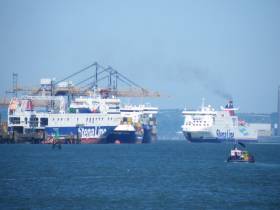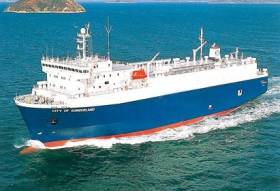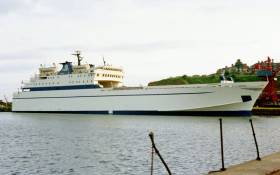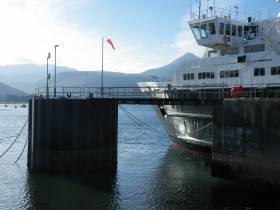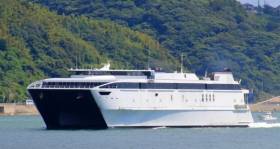Displaying items by tag: Ferry news
Ferry Fleet to Undergo £7m Annual Refit Contract at Harland & Wolff
#AnnualRefits - The bulk of Stena Line's Irish Sea fleet are to undergo a £7m annual refit and maintenance programme contract at Harland & Wolff’s Belfast shipyard.
Each year Stena Line carries out a series of passenger facility upgrade works as well as a number of scheduled maintenance and engine works to its fleet of 11 ferries on the Irish Sea. The Harland & Wolff refit schedule for 9 of the Irish Sea fleet will start at the end of December and will run through until early May 2017 to ensure that Stena Line’s sailing schedules are not unduly impacted.
Paul Grant, Stena Line’s Route Manager (Irish Sea North) commented: “The marine refit sector is a highly competitive market and I’m delighted to confirm that Stena Line has appointed Harland & Wolff to carry out this important operational project. Stena Line is committed to supporting the local communicates in which it operates and with our expanding operations hub at Belfast Port, having a world class refit expertise close by is a real benefit. 2016 has been a record year for Stena Line across our car, passenger and freight markets on our Belfast to Cairnryan, Liverpool and Heysham routes and once completed, the refit programme will help us to maintain our market leading position into 2017.”
Stuart Wilson, General Manager of Harland & Wolff’s Ship Repair Division said: “By docking their Irish Sea fleet with us on an annual basis, Stena Line’s business has become an integral part of our ship repair activities, providing valuable support not just to our company but also to the local supply chain, who provide specialist and ancillary services as part of the vessel dockings”.
#CityRiverFerry – Last night’s Late Late Show’s competition for a holiday in the UK capital is where visitors can take in the sights of the famous River Thames, which is to benefit with new larger passenger craft in summer 2017, writes Jehan Ashmore.
The order for a pair of 170 passenger craft represents the largest fast passenger ferries contracted from a UK shipyard in over 25 years. Confirmation of the order was recently announced by shuttle river-bus operator, MBNA Thames Clippers. By the end of this year, they are to carry over four million commuters and tourists alike on Old Father Thames through central London.
MBNA Thames Clippers, have placed the £6.3m order for the 35m high-speed craft with an Isle of Wight yard. They will add 14% in capacity to the network and increase frequency. The newbuilds follow a pair of 150 passenger catamarans dating only to 2015. The fleet currently totals 15 craft, which includes Meteor Clipper pictured above (when captured from under London Bridge).
Asides the busy commuter routes, MBNA Thames Clipper also serve the O2 Arena (former Millennium Dome) downriver in the north Greenwich area, by making before and after event trips.
This service echoes that of a Dublin operation during the mid-1990’s, where Liffey Line had a shuttle river-bus linking City Quay (near Tara DART Station) downriver to the Point Theatre at the North Wall. This is also where round-trips where made from the city-centre to serve patrons of the theatre. The venue would latter become the The O2 currently is now named the 3Arena.
The craft used was formerly from the Shannon, in which I recall plying the Liffey with advertising hoardings sponsored by Guinness. At the time this bought fresh memories of the stout tankers, The Lady Patricia and Miranda Guinness that had only been disposed a few years previously.
Afloat on another posting will be examining in more detail other operations on the Liffey. This will feature both past and present 'excursion' only operator, Dublin Discovered Boat Tours.
Extra Freight Capacity Added On Belfast Route Prior to Christmas
#ExtraCapacity - Additional freight capacity by Stena Line on the Belfast-Liverpool service began today, in support of the retail sector in preparation for the key pre-Christmas trading period.
Stena Line is adding an extra two sailings per week, from Friday, 21st October until 16th December. It will operate an additional Friday departure from Belfast (15.30hrs) and from Monday 24th October until 19th December it will operate an additional Monday departure (08.00hrs) from Birkenhead, Liverpool.
The extra sailings will provide increased freight capacity for up to 2 000 more freight units across the Irish Sea at a crucial time for businesses seeking to maximise their Christmas trade.
Richard Horswill, Stena Line’s Head of Freight (UK and Ireland) said: “The extra sailings we have announced today represent an additional 25% capacity on our Belfast-Liverpool freight only service with departures times designed to optimise customer delivery schedules. Since we acquired the route in 2011, this service has gone from strength to strength, especially with our freight customers, so we are confident the additional capacity will be welcome news for the freight industry at this busy time of the year.”
“Putting extra capacity on now comes at a critical time for many businesses who rely on pre-Christmas sales to make a success of their trading year. As the largest operator on the Irish Sea, we have the flexibility to respond to the needs of the market and deploy additional freight capacity where and when it’s most needed.”
Reports of Nissan Eyeing Up Cork Site "Just Not True"
#CorkCars? - Nissan Europe have dismissed speculation, writes TheJournal.ie, that it is interested in taking over a site south of Cork City at the 130-acre former Amgen facility in Carrigtwohill.
Fianna Fáil city councillor Kenneth O’Flynn had claimed that he had been tipped off by industry insiders that the Japanese automobile production giant may be interested in locating to east Cork.
Nissan Europe’s lukewarm response as to whether it was fully committed to Sunderland in the north- east of the UK in the wake of Brexit had increased speculation about its future plans.
However, a spokesperson for Nissan Europe was unequivocal in her response when contacted by the Evening Echo. She said: “There’s nothing to this tip-off.”
To read more and of the FF councillor views on the use of Port of Cork click here.
In addition see: Seatruck’s new Dublin-Bristol trade car route that follows in the wake of 1970's car industry serving Dublin and notably the Port of Cork and related former Ford assembly plant.
Almost Full Circle: Seatruck's New Bristol Trade Car Route Recalls Seaspeed's Dublin / Cork Era
#Almost360 – Seatruck Ferries launch of new Dublin-Bristol route last month is almost full circle, as a similar trade car service began more than 40 years ago, albeit instead using a south Wales port, writes Jehan Ashmore.
The ro-ro Clipper Ranger, an R class freight ferry with a capacity for 165 unaccompanied trailer units has been in service since early September on the English route. The Port of Bristol (Portbury) is where the UK west coast port is also a major hub for car imports. This is where Seatruck have tapped into the car manufacturering industry by entering the Irish marketplace through Dublin Port.
In a further developent, according to today's TheJournal.ie, Nissan has denied speculation it will move to Cork as the car manufacturer would either build a new facility or move its Sunderland car plant to the Irish city.
Asides the speculation, Seatruck’s new service is the first ro-ro freight only service connecting Dublin and a Bristol Channel port since the early 1970’s. It is again this role of the car industry that links the Ireland-UK connection to more than four decades ago as in 1974, Seaspeed Ferries established a Dublin-Barry route and in the same year added a second link, Cork-Barry in south Wales.
The Irish city is where Ford had an assembly plant rolling out cars off the production line. Large numbers of completed vehicles, however were also imported in which Seaspeed secured that contract.
The Ford contract proved so successful for Seaspeed, that they increased the Celtic Sea route from once weekly to that of twice weekly on the Barry-Cork service. The newcomer during their tenure on both Barry-Dublin /Cork routes was served by three vessels. Seaspeed Ferry, Seaspeed Trailer and Seaspeed Challenger which traded for Seaspeed Ferries Corporation, Piraeus.
The Greek based operator, however faced what they claimed a lack of co-operation from B+I Line, to whom they shared the linkspan at Cork’s Tivoli terminal. This was a contributory factor that led to Seaspeed pulling out of Cork in late 1975 and instead concentrate on Dublin-Barry operations.
In an ironic twist, Seaspeed Challenger was chartered by B+I Line years later, when in 1989 the state-owned ferry operator had to seek tonnage to increase freight capacity on Rosslare-Pembroke Dock route. B+I had failed to secure a passenger car ferry that could also handle adequate freight capacity on the St. Georges Channel route to Pembroke Dock.
During the charter to B+I, Seaspeed Challenger, had since changed hands and named as Oleander under Cypriot flag. The 3,163 tonnes vessel presented an unusual appearance in Irish waters, given her Mediterranean naval architecture background, sporting sweeping lines having been launched in 1973 as Monica Russotti in Messina, Sicily. Such Italian styling was notably taken in when an opportunity arose to board the then red hulled vessel at Rosslare in between freight sailings.
Rivals, Sealink British Ferries serving Fishguard, had chartered Earl Harold, a former Channel Islands car ferry to B+I Line. Uniquely, the SBF ferry was liveried in her Irish counterpart colours.
Returning to B+I’s operations at Cork, the linkspan at Tivoli was not just for their south Wales link but also served Brittany Ferries on their continental crossings to and from Roscoff. The present day terminal is 12 miles downriver at Ringaskiddy in lower Cork Harbour. Sadly, Brittany Ferries are the sole users of the facility on which the seasonal-only service ceases early next month.
CalMac's New £900m Scottish West Coast Contract Begins
#CalMacContract - The £900m ferry contract to operate Scottish west coast services awarded to CalMac Ferries Ltd by Transport Scotland earlier this year, has been in force for almost a week.
The contract that began last Saturday, 1 October is valid for the next eight years which will see the extensive network of Western Isles and Clyde ferry operations remain in public hands.
Customers travelling by ferry from the first day of the contract will also see a new 'operator mark' which has been produced to show that Caledonian MacBrayne is operated by CalMac Ferries Ltd. It will not replace the familiar iconic lion rampant heraldic device on ships but will be rolled out across the network in a variety places including on uniforms, on ships, in ports and in printed material, as part of a tender requirement set by Transport Scotland.
CalMac Managing Director Martin Dorchester said: "The new operator mark may seem a small change but it is symbolic of the positive changes we are bringing to the new contract, and will be worn and displayed with pride by everyone at CalMac."
He said: "The start of this contract marks the culmination of almost two years of hard work to develop and submit our bid for the new contract, and everyone at CalMac, and the communities who rely on our ferry services, who provided input and support, can be very proud of their achievement."
"Since the announcement in May and the formal signing of the new contract at the end of August we have been doing the ground work to convert our winning proposals into improvements which will transform the onboard travel experience for our customers over the life of the contract.
These include:
• Providing the most up to date customer information available
• Providing a modern ticketing system.
• Improving accessibility for customers.
• Improving integration with other modes of transport
• Investing £6 million to refresh the appearance of vessels and ports (see redevelopment of terminal at Brodick, Isle of Arann)
He said: "Clearly some of these will take some time to work through, and the delay to signing the contract has also had an impact on progress, but some improvement are already well in hand, and our commitment to these is enshrined in the contract which is legally binding and will be closely managed by our client, Transport Scotland.
"After the years of uncertainty over our future I know everyone is looking forward to playing a part in this an exciting new chapter in the story of CalMac and these vitally important ferry services."
#TrafficGrowth - Two Irish Sea routes linking Belfast to English ports of Liverpool and Heysham operated by Stena Line have shown significant growth following their acquisition from DFDS five years ago.
Since the £40m purchase in 2011, Stena Line’s carryings on the routes have gone steadily increased with approximately 1.3m guests, 370,000 cars and 1.45m freight units making the trip across the Irish Sea.
Freight volumes on the two routes since Stena Line took them over have increased by 37%*, with passenger numbers rising by 14.5%* and car traffic growing by 8.4%* during the same period.
Investment in the routes has been significant with more than £9 million spent since 2011 across all aspects of the service, including cabin improvements, upgrades to the truckers lounge, the introduction of premium Stena Plus lounges and quiet rooms, and an overhaul of the ships’ existing bar and restaurant facilities to bring them into line with the rest of the Stena Line fleet.
In addition, they have added extra capacity and frequency via the introduction of a fifth ship serving Birkenhead and Heysham. In 2013, the company added extra freight tonnage to the Liverpool service in the form of the Stena Hibernia which provided an extra eight trips per week, increasing capacity by 30.8% and bringing the total number of weekly sailings to 34 across both routes.
* Statistics are based on most recent full year figures (2015) vs last full year figures prior to acquisition (2010).
New Strangford Lough Car Ferry to Make Autumn Debut
#NewbuildFerry - A new £6m double ended carferry for Strangford Lough, Northern Ireland as previously reported is due to enter service this autumn, writes Jehan Ashmore.
The Department for Infrastructure (DfI) has established a project for the delivery of two ferries – one for the Ballycastle, Co. Antrim to Rathlin Island ferry launched last week by Arklow Marine Services. The second ferry is for the Strangford Lough Ferry Service, following a contract from the DFI for the 28 vehicle/260 passenger newbuild was awarded to Cammell Laird, Birkenhead.
When in service, the new ferry named MV Strangford II will alternate with MV Portaferry II to service the route between Strangford and Portaferry, Co. Down. The 10 minute service is operated on a half-hourly schedule.
The DFI has responded to Afloat.ie on what awaits the fate of MV Strangford (built in 1969 by Verolme Dockyard, Cork) and the passenger only MV Rachlyn. The DFI commented that they have engaged the Disposal Services Authority (DSA) to arrange disposal of both vessels, which will no longer be required when the new replacement ferry, Strangford II comes into operation.
The DSA has invited expressions of interest to arrive by 13 October and it is anticipated that the vessels will be sold later this year.
Final Day to Vote for Ferry to Be Produced in Lego!
#VoteLegoFerry - A Scottish teenager, Luke Ball from Kilmarnock, has a dream to see his design of an iconic Calmac ferry produced in Lego.
Luke who turned 16 on Wednesday, writes Largs & Millport Weekly, has spent the last 18 months gathering support for his Lego version of CalMac’s Forth of Clyde ferry MV Loch Shira that serves between Largs and Isle of Cumbrae.
His model design has so far gained a great following of 3,450 supporters on the Lego Ideas site – but to keep the dream alive the project must reach 5000 supporters before today's deadline of Friday 30th September for it to be considered for production.
Luke’s ferry design was inspired by happy family journeys on the Firth of Clyde and took him many hours to put together.
Without a final push and sudden rush of support, his design won’t make it onto the desks of the Lego executives.
You can help by supporting his design at https://ideas.lego.com/projects/99373
For more on the story, click here.
ICG Extend Charter of Fast-Ferry Westpac Express
#ExtendedCharter - Irish Continental Group has announced today, following their statement issued on 2 June this year, the charter to Sealift LLC of the High Speed Craft "Westpac Express" for a further fixed period of 12 months to October 2017.
Sealift LLC in turn have chartered the Vessel to Military Sealift Command, a U.S government organisation. The charter is subject to usual US government procurement regulations.
The vessel was built in 2001 by Austal Ships, Australia. It has a gross tonnage of 8,403 tonne, passenger capacity of 900 and a car carrying capacity of 182 units.



























